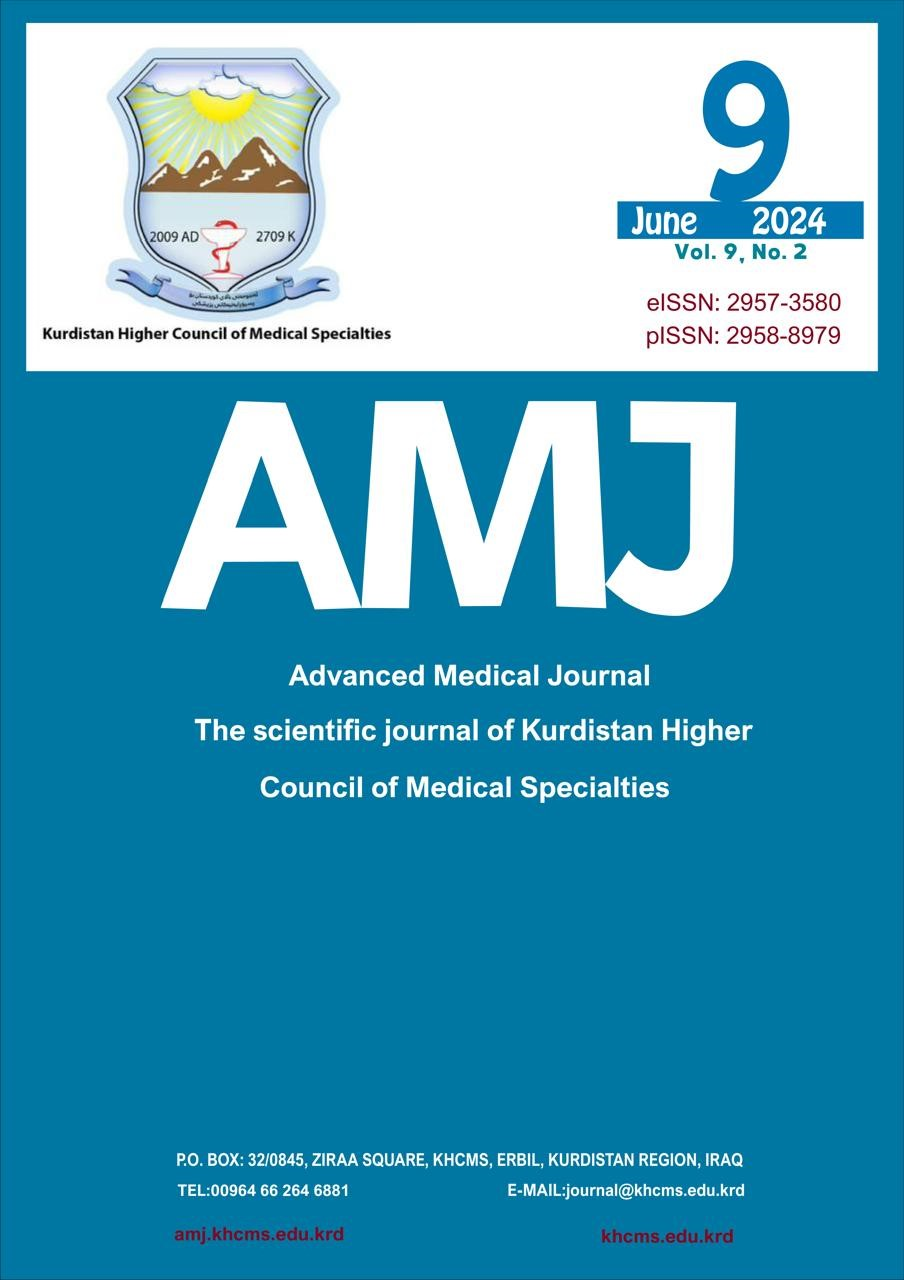Programmed Death Ligand 1 expression in Urothelial Carcinoma.A retrospective study in Duhok City-Iraq.
DOI:
https://doi.org/10.56056/amj.2024.257Keywords:
Combined positive score, PDL-1, Urothelial cancerAbstract
Background and objective: Programmed death ligand-1 protein expression has been linked to the severity of Urothelial cancer. The objectives of this study were to evaluate the expression of programmed death-ligand 1 and determine the association with tumour grade, stage, type (Papillary and non papillary), muscle invasion, age, and gender.
Methods: This retrospective study was carried out from 2015 to 2022 on fifty-eight blocks belonging to patients with urothelial carcinoma, which were obtained from Duhok central lab and private laboratory. From each block, two sections were made; one of which was stained with Hematoxylin and Eosin for histological re-assessment and the other one for immunostaining for programmed death-ligand-1, which was calculated in tumour cells and inflammatory cells regardless of staining intensity and then the combined positive score was determined and considered positive when is more than 10.
Result: This study included 58 cases of Urothelial carcinoma, Females represent 8 (13.79%) cases and males 50 (86.21%) cases, with a female-to-male ratio of 1/6.25. No statistically significant association existed between the histological subtypes and gender. Combined positive score was positive in (32.76%) of cases and negative (67.24%) cases. The association was significant with the stage of the tumor (p=0.03), muscle invasion (p=0.02) and highly significant with grade (p<0.001).
Conclusion: patients with urothelial carcinoma who have higher tumour grade, advanced stage and those who with muscle invasion can benefit from immune check point inhibitors.
Downloads
References
Han Y, Liu D, Li L. PD-1/PD-L1 pathway: current researches in cancer. Am J Cancer Res. 2020;10(3):727-42.
Boussiotis VA. Molecular and Biochemical Aspects of the PD-1 Checkpoint Pathway. N Engl J Med. 2016;375(18):1767-78.
Lin K, Cheng J, Yang T, Li Y, Zhu B. EGFR-TKI down-regulates PD-L1 in EGFR mutant NSCLC through inhibiting NF-?B. Biochem Biophys Res Commun. 2015;463(1-2):95-101.
Ji M, Liu Y, Li Q, et al. PD-1/PD-L1 pathway in non-small-cell lung cancer and its relation with EGFR mutation. J Transl Med. 2015;13:5.
Bellucci R, Martin A, Bommarito D, et al. Interferon-?-induced activation of JAK1 and JAK2 suppresses tumor cell susceptibility to NK cells through upregulation of PD-L1 expression. Oncoimmunology. 2015;4(6):e1008824.
Gulinac M, Dikov D, Velikova T, Belovezhdov V. Increased PD-L1 expression in high-grade bladder cancer with squamous cell differentiation in Bulgarian and French patients' samples. Ann Diagn Pathol. 2020;49:151640.
Kythreotou A, Siddique A, Mauri FA, Bower M, Pinato DJ. Pd-L1. J Clin Pathol. 2018;71(3):189-94.
Wang X, Teng F, Kong L, Yu J. PD-L1 expression in human cancers and its association with clinical outcomes. Onco Targets Ther. 2016;9:5023-39.
Mu CY, Huang JA, Chen Y, Chen C, Zhang XG. High expression of PD-L1 in lung cancer may contribute to poor prognosis and tumor cells immune escape through suppressing tumor infiltrating dendritic cells maturation. Med Oncol. 2011;28(3):682-8.
Nakanishi J, Wada Y, Matsumoto K, Azuma M, Kikuchi K, Ueda S. Overexpression of B7-H1 (PD-L1) significantly associates with tumor grade and postoperative prognosis in human urothelial cancers. Cancer Immunol Immunother. 2007;56(8):1173-82.
Zhu J, Li Y, Luo Y, et al. A Feedback Loop Formed by ATG7/Autophagy, FOXO3a/miR-145 and PD-L1 Regulates Stem-Like Properties and Invasion in Human Bladder Cancer. Cancers (Basel). 2019;11(3).394.
Humphrey PA, Moch H, Cubilla AL, Ulbright TM, Reuter VE. The 2016 WHO Classification of Tumours of the Urinary System and Male Genital Organs—Part B: Prostate and Bladder Tumours. Eur Urol. 2016;70(1):106-19.
Amin MB, Greene FL, Edge SB, et al. The Eighth Edition AJCC Cancer Staging Manual: Continuing to build a bridge from a population-based to a more “personalized” approach to cancer staging. CA Cancer J Clin. 2017;67(2):93-9.
Lee KS, Choe G. Programmed cell death-ligand 1 assessment in urothelial carcinoma: prospect and limitation. J Pathol Transl Med. 2021;55(3):163-70.
Brown JA, Dorfman DM, Ma FR, et al. Blockade of programmed death-1 ligands on dendritic cells enhances T cell activation and cytokine production. J Immunol. 2003;170(3):1257-66.
Topalian SL, Hodi FS, Brahmer JR, et al. Safety, activity, and immune correlates of anti-PD-1 antibody in cancer. N Engl J Med. 2012;366(26):2443-54.
Taube JM, Anders RA, Young GD, et al. Colocalization of inflammatory response with B7-h1 expression in human melanocytic lesions supports an adaptive resistance mechanism of immune escape. Sci Transl Med. 2012;4(127):127ra37.
Al Nabhani S, Al Harthy A, Al Riyami M, et al. Programmed Death-ligand 1 (PD-L1) Expression in Bladder Cancer and its Correlation with Tumor Grade, Stage, and Outcome. Oman Med J. 2022;37(6):e441-e.
Nechifor-BoilIA, Loghin A, Nechifor-BoilA, et al. PD-L1 Expression in Muscle Invasive Urothelial Carcinomas as Assessed via Immunohistochemistry: Correlations with Specific Clinical and Pathological Features, with Emphasis on Prognosis after Radical Cystectomy. Life (Basel, Switzerland). 2021;11(5):404.
Faraj SF, Munari E, Guner G, et al. Assessment of tumoral PD-L1 expression and intratumoral CD8+ T cells in urothelial carcinoma. Urology. 2015;85(3):703.e1-6.
Kawahara T, Ishiguro Y, Ohtake S, et al. PD-1 and PD-L1 are more highly expressed in high-grade bladder cancer than in low-grade cases: PD-L1 might function as a mediator of stage progression in bladder cancer. BMC Urol. 2018;18(1):97.
Ding X, Chen Q, Yang Z, et al. Clinicopathological and prognostic value of PD-L1 in urothelial carcinoma: a meta-analysis. Cancer Manag Res. 2019;11:4171-84.
Seranio N, Malkowicz S, Aguarin L, Dorsey J, Christodouleas J, Kao GJJTS. Predicting bladder cancer responses to PD-L1 inhibitors? A case report and overview for the busy clinician. 2019;5.
Eckstein M, Cimadamore A, Hartmann A, et al. PD-L1 assessment in urothelial carcinoma: a practical approach. Ann Transl Med. 2019;7(22):690.
Downloads
Published
How to Cite
Issue
Section
License
Copyright (c) 2024 Zuzan Shawkat Mustafa , Gina James Keorges, Alaa Hani Raziq

This work is licensed under a Creative Commons Attribution-NonCommercial-ShareAlike 4.0 International License.
The copyright on any article published in AMJ (The Scientific Journal of Kurdistan Higher Council of Medical Specialties )is retained by the author(s) in agreement with the Creative Commons Attribution Non-Commercial ShareAlike License (CC BY-NC-SA 4.0)









